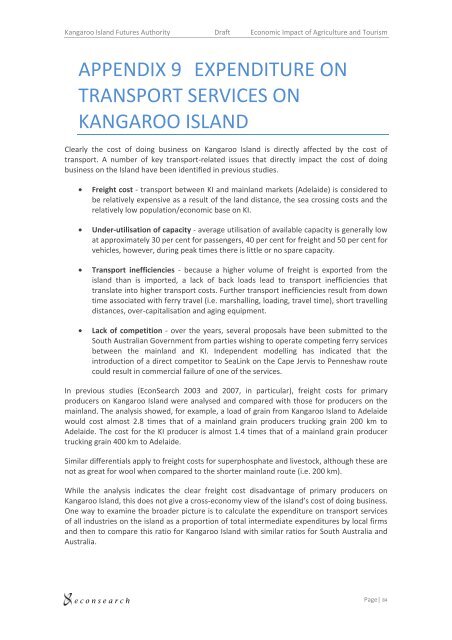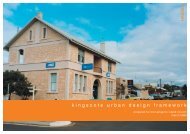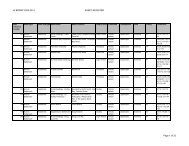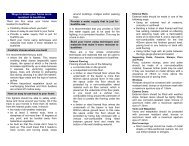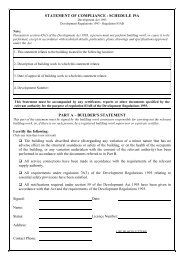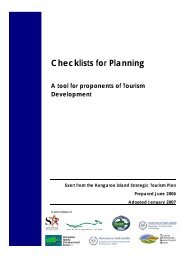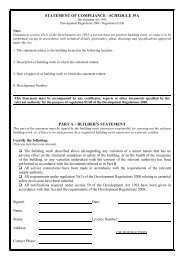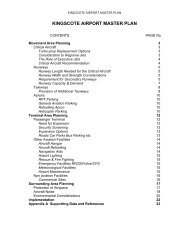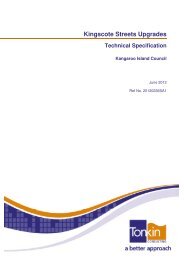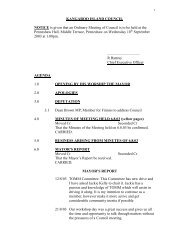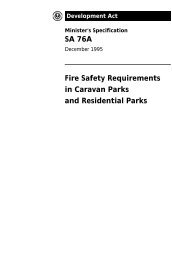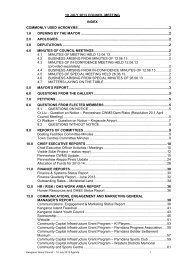Kingscote Airport Business Case Appendices - Kangaroo Island ...
Kingscote Airport Business Case Appendices - Kangaroo Island ...
Kingscote Airport Business Case Appendices - Kangaroo Island ...
- No tags were found...
You also want an ePaper? Increase the reach of your titles
YUMPU automatically turns print PDFs into web optimized ePapers that Google loves.
<strong>Kangaroo</strong> <strong>Island</strong> Futures Authority Draft Economic Impact of Agriculture and TourismAPPENDIX 9 EXPENDITURE ONTRANSPORT SERVICES ONKANGAROO ISLANDClearly the cost of doing business on <strong>Kangaroo</strong> <strong>Island</strong> is directly affected by the cost oftransport. A number of key transport-related issues that directly impact the cost of doingbusiness on the <strong>Island</strong> have been identified in previous studies.• Freight cost - transport between KI and mainland markets (Adelaide) is considered tobe relatively expensive as a result of the land distance, the sea crossing costs and therelatively low population/economic base on KI.• Under-utilisation of capacity - average utilisation of available capacity is generally lowat approximately 30 per cent for passengers, 40 per cent for freight and 50 per cent forvehicles, however, during peak times there is little or no spare capacity.• Transport inefficiencies - because a higher volume of freight is exported from theisland than is imported, a lack of back loads lead to transport inefficiencies thattranslate into higher transport costs. Further transport inefficiencies result from downtime associated with ferry travel (i.e. marshalling, loading, travel time), short travellingdistances, over-capitalisation and aging equipment.• Lack of competition - over the years, several proposals have been submitted to theSouth Australian Government from parties wishing to operate competing ferry servicesbetween the mainland and KI. Independent modelling has indicated that theintroduction of a direct competitor to SeaLink on the Cape Jervis to Penneshaw routecould result in commercial failure of one of the services.In previous studies (EconSearch 2003 and 2007, in particular), freight costs for primaryproducers on <strong>Kangaroo</strong> <strong>Island</strong> were analysed and compared with those for producers on themainland. The analysis showed, for example, a load of grain from <strong>Kangaroo</strong> <strong>Island</strong> to Adelaidewould cost almost 2.8 times that of a mainland grain producers trucking grain 200 km toAdelaide. The cost for the KI producer is almost 1.4 times that of a mainland grain producertrucking grain 400 km to Adelaide.Similar differentials apply to freight costs for superphosphate and livestock, although these arenot as great for wool when compared to the shorter mainland route (i.e. 200 km).While the analysis indicates the clear freight cost disadvantage of primary producers on<strong>Kangaroo</strong> <strong>Island</strong>, this does not give a cross-economy view of the island’s cost of doing business.One way to examine the broader picture is to calculate the expenditure on transport servicesof all industries on the island as a proportion of total intermediate expenditures by local firmsand then to compare this ratio for <strong>Kangaroo</strong> <strong>Island</strong> with similar ratios for South Australia andAustralia.e c o n s e a r c hPage| 84


